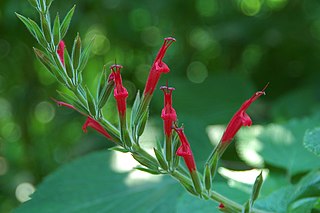
Salvia elegans, a species with several varieties including pineapple sage and tangerine sage, is a perennial shrub native to Mexico.

Salvia greggii, the autumn sage, is a herbaceous perennial plant native to a long, narrow area from southwest Texas, through the Chihuahuan Desert and into the Mexican state of San Luis Potosi, typically growing in rocky soils at elevations from 5,000 to 9,000 ft. It was named and described in 1870 by botanist Asa Gray after Josiah Gregg, a merchant, explorer, naturalist, and author from the American Southwest and Northern Mexico, who found and collected the plant in Texas. It is closely related to, and frequently hybridizes with, Salvia microphylla. Despite the common name "autumn sage", it blooms throughout the summer and autumn.
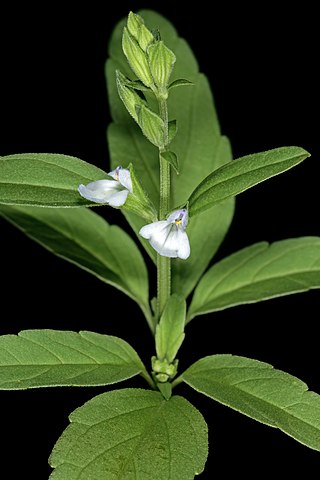
Salvia reflexa, the lanceleaf sage, Rocky Mountain sage, blue sage, lambsleaf sage, sage mint or mintweed, is an annual subshrub native to the United States and Mexico and introduced to Argentina, Australia, Canada, South Africa and New Zealand.
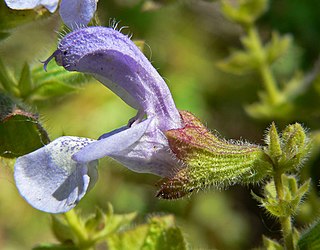
Salvia africana is a heavy branched aromatic perennial shrub native to the coast of the Cape Provinces of South Africa, found on coastal dunes and in nearby rocky hills up to 600 m elevation. It grows to 60–90 cm, with round grayish stems covered with hairs that release a strong scent when brushed. The leaves are a soft grey-green, lighter on the underside, and elliptical shaped. The inflorescences reach 30 cm long, with 2-6 flowers in each whorl, ranging from pale blue to pale violet or pink.
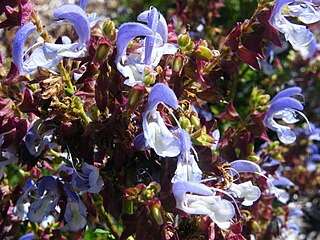
Salvia chamelaeagnea is a species of flowering plant in genus Salvia, known as sages. It is endemic to South Africa, where it grows on the western coastline of the Cape of Good Hope. It is a shrubby perennial herb up to 6 feet tall and 4 feet wide. It bears three-quarters-inch (two-centimetre) light violet-blue flowers with pale lower lips and white throats. The small, green leaves release a slight medicinal odor when brushed. In the wild, the plant grows in sandy soil in streambeds, open fields, and roadsides. It is cultivated for gardens.
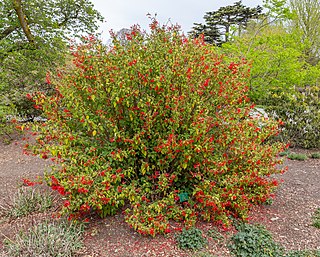
Salvia gesneriflora is a herbaceous perennial plant or subshrub native to mountainous provinces of the Sierra Madre Oriental in Mexico, growing at 7,500–10,000 ft (2,300–3,000 m) elevation. The long tubular flowers of this salvia resemble Gesneria flowers. It is a popular ornamental plant.
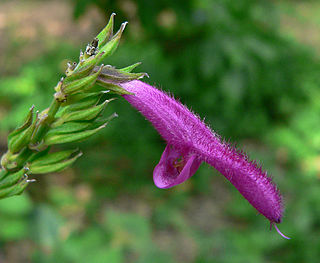
Salvia iodantha is a herbaceous perennial native to the mountains of central Mexico, growing between 2,600 and 10,500 ft elevation. It was described by Merritt Lyndon Fernald in 1900 and began appearing in horticulture in the 1980s.

Salvia koyamae (Shinano-akigiri) is a perennial rarely found in the wild and native to the Japanese island of Honshu, where it has a close affinity to two other salvia species: Salvia glabrescens and Salvia nipponica. It was named by Tomitaro Makino, considered the "father of Japanese botany".
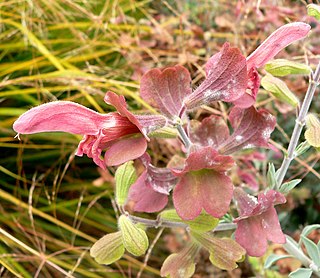
Salvia lanceolata is a perennial shrub native to a small area of coast on the Cape of Good Hope in South Africa. It is typically found growing in sandy ground at sea level, and on dry hills and flat ground up to 1000 feet elevation. Jean-Baptiste Lamarck, a pioneer in evolutionary theory, first described and named the plant "lanceolata" in 1791. Swedish botanist Carl Peter Thunberg, who was delayed in South Africa on the way to Japan, first collected it nearly twenty years earlier, along with approximately 3,000 plants that he later described. It wasn't until 1800 that Thunberg gave the plant the specific epithet "nivea", meaning 'snowy' in Latin, referring to the color of the foliage. Because of the rules of nomenclature, Lamarck's name had precedence because he was the first to name it.
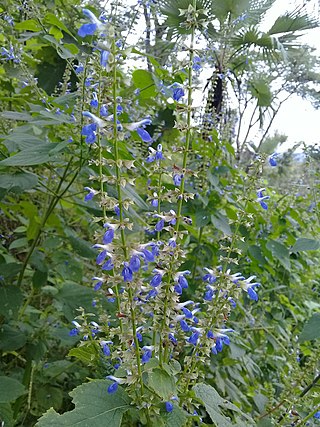
Salvia longispicata is a perennial shrub native to southwestern Mexico, growing between 1,000 and 6,500 feet elevation. The specific epithet "longispicata" gives the impression that the plant has "long spikes", but instead refers to the many projecting clusters of short flowering spikes that resemble small ears of corn.

Salvia merjamie is a herbaceous perennial plant that is native to the east African highlands from Ethiopia to Tanzania, and also across the Red Sea in Yemen. It grows between 6,000 and 13,000 feet elevation in grasslands, forest edges, rocky outcrops, basalt slopes, and fallow fields. The specific epithet merjamie is derived from meryamiye, the Arabian common name for the plant, which is shared with other local Salvia species such as Salvia lanigera. The Maasai common name for S. merjamie is Naingungundeu, meaning that the plant smells of rats, though the variety that is common in horticulture is named 'Mint Sauce' and is described as having a strong minty aroma. S. merjamie shares a similar distribution with Salvia nilotica, though they are not known to hybridize.

Salvia namaensis is an evergreen perennial shrub native to a limited area in Namibia and a wide area of South Africa. It is typically found growing on rocky slopes, shales, limestone hills, and sandy soils at 1,000 to 5,000 feet elevation. The specific epithet namaensis probably refers to the Nama tribe which is indigenous to Namaqualand, the region in Namibia where the plant grows.

Salvia roborowskii is an annual or sometimes biennial herb that is native to a wide area that includes Tibet, Sikkim, and five provinces in China, growing on wet stream banks, grasslands, and hillsides between 8,000 and 12,000 feet elevation.

Salvia rypara is a herbaceous perennial native to Argentina and Bolivia—due to its being very adaptable it is reported to be naturalized in Mexico and possibly Central America. It prefers stream bank habitats, as the specific epithet rypara implies. It also grows in weedy thickets, thriving at elevations under 3,000 feet. Described by John Isaac Briquet in 1896, it is not very well known in horticulture, with only a few gardeners growing it since the 1990s. It is becoming more well known in the United States, France, England, and Italy because it is easy to grow and makes a very attractive garden plant.

Salvia scabra is a herbaceous perennial native to the southeastern strand of the Cape of Good Hope in South Africa, growing on sandy shores, coastal brush, and hilly slopes up to an elevation of 600 feet. It was described and named by Carl Thunberg in 1800. The leaves and an extract from the roots have been used medicinally in its native region for at least one hundred years. Salvia scabra was introduced to California gardens around 1996, and is extremely adaptable to many types of conditions. Since then it has spread to gardens in England, France, and Italy.
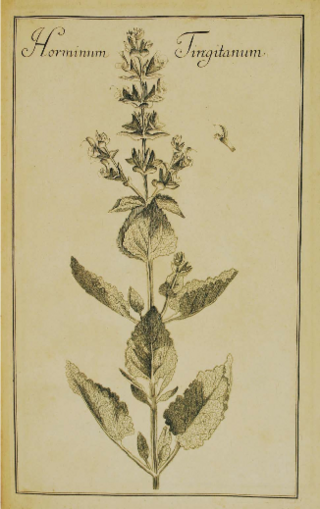
Salvia tingitana is an herbaceous perennial in the family Lamiaceae. It has a long and enigmatic history—it has been grown and described since the 17th century without any certainty about its origin. Botanists' speculation that it was native to northern Africa is reflected in the specific epithet tingitana, which refers to the town of "Tingi", even though no native plants have ever been found there. It was not until 1989 that a wild population of the plant was discovered, in western Saudi Arabia. The plant is regarded as a rather strong mosquito repellent commonly used in traditional medicine of Behbahan where it blooms around March.

Salvia stenophylla is a perennial shrub native to a wide area of Southern Africa: South Africa, Botswana and Namibia. It grows on grassy or stony slopes, and in open countryside or among shrubs. It has been used traditionally as a disinfectant by burning it in huts after sickness, and it is also mixed with tobacco for smoking. Its specific epithet, stenophylla, refers to the narrow leaves.

Salvia transsylvanica is a species of flowering plant in the family Lamiaceae. It is a herbaceous perennial native to a wide area from north and central Russia to Romania. It was described and named in 1853 by botanist Philipp Johann Ferdinand Schur, with the specific epithet referring to the Transylvanian Alps located in central Romania. It was introduced into horticulture in the 1980s.

Salvia thermarum is a perennial native to South Africa, discovered in 1998 by Ernst van Jaarsveld of Cape Town's Kirstenbosch National Botanical Garden. The common name is based on the location of the plant's discovery, near Goudini Spa, approximately 120 km from Cape Town—the specific epithet, thermarum, refers to the thermal baths where it was found. It is only found native in the Cape Provinces.
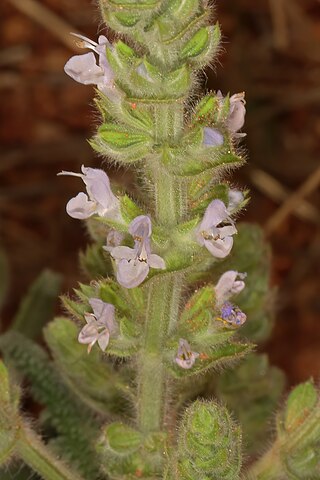
Salvia radula is a herbaceous perennial native to the northern provinces of South Africa, growing at elevations from 1,300 to 1,900 m. The plant grows to 0.3 to 0.75 m tall. Leaves are wooly and white underneath. It is closely related to Salvia disermas.




















